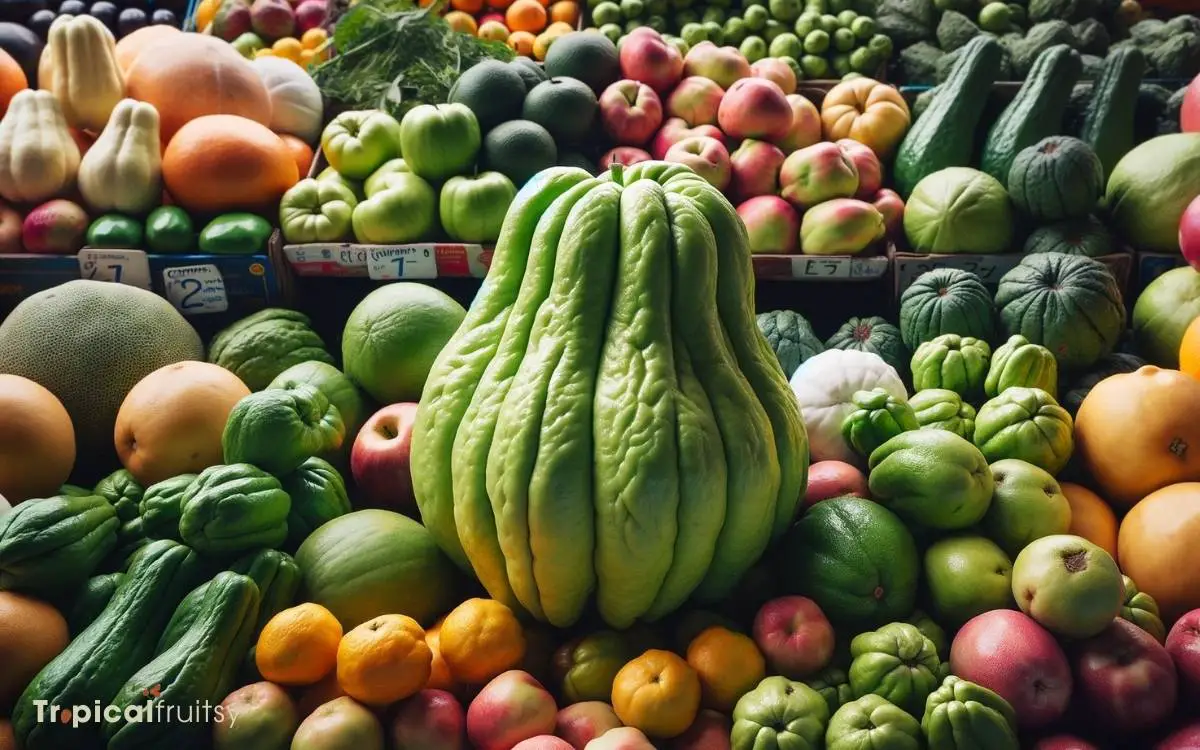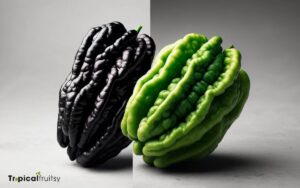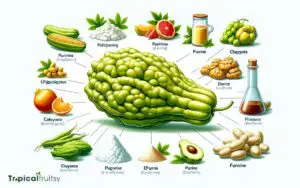Is Chayote a Fruit or Vegetable? Unveiling Nature’s Secrets!
Chayote, known scientifically as Sechium edule, is classified botanically as a fruit but is commonly used as a vegetable in culinary practices.
Chayote belongs to the gourd family, Cucurbitaceae, which includes well-known vegetables like cucumbers, melons, and squashes.
As a fruit, it develops from the plant’s flower and contains seeds. However, its usage in cooking is more akin to that of vegetables, featuring predominantly in savory dishes. Its mild taste and adaptability in recipes have led to its vegetable categorization in the kitchen.
Chayote’s versatility in the kitchen and garden highlights its unique role in both botanical and culinary realms.

Key Takeaway
Understanding Chayote Basics
What exactly is chayote, and how does it fit into the botanical classifications that distinguish fruits from vegetables?
Chayote, scientifically designated as Sechium edule, is a perennial climber plant belonging to the gourd family Cucurbitaceae.
Botanically, it is classified as a fruit, specifically an accessory fruit, a category that includes produce with parts that develop from tissues exterior to the carpels.
The chayote fruit originates from an inferior ovary and features a single, large seed enclosed within a fleshy pericarp.
Analytically, in culinary contexts, the chayote is often treated as a vegetable due to its mild flavor profile and the manner in which it is prepared and consumed—typically as an ingredient in savory dishes rather than sweet.
This dichotomy illustrates the complexity of categorizing botanical fruits in everyday language.
Botanical Definition Explained
Considering its development from an inferior ovary and possession of a seed, the chayote is botanically defined as a fruit based on certain reproductive criteria.
The botanical classification of chayote is rooted in its morphological development and reproductive functions.
To delineate the technical distinctions, the following table contrasts chayote’s defining characteristics with general botanical definitions:
| Botanical Characteristic | Chayote’s Attribute |
|---|---|
| Origin from the plant | Develops from the ovary of the Sechium edule flower |
| Reproductive role | Contains seed necessary for species propagation |
| Classification type | Categorized as a fruit based on its development and structure |
This analytical approach underscores the precise nature of chayote as a fruit from a botanical perspective, aligning with the reproductive criteria that govern plant taxonomy.
Culinary Classification Insights
In culinary contexts, chayote is typically classified as a vegetable due to its savory applications and preparation methods in dishes.
This is consonant with the general culinary practice of designating produce with less sweetness and more versatility in savory dishes as vegetables.
Chayote, with its mild flavor and firm texture, is frequently incorporated into a variety of recipes ranging from stir-fries to stews. It is treated similarly to other squash varieties, often being diced, sautéed, or blended into soups.
The culinary perspective emphasizes the role of chayote as a complementary ingredient that adapts to and enhances the flavor profiles of other components within a dish, rather than serving as a sweet or tart centerpiece, which is more characteristic of fruits in the culinary realm.
Nutritional Profile Overview
One should note that chayote is a low-calorie food rich in essential nutrients such as vitamin C, fiber, and various minerals.
A single chayote (approximately 203 grams) contains a mere 38.6 calories, illustrating its potential role in weight management and obesity prevention.
It provides about 15% of the recommended daily value (DV) for vitamin C, a critical antioxidant that supports immune function and skin health.
Moreover, chayote is a good source of dietary fiber, offering about 3.5 grams per serving, which is beneficial for digestive health and can aid in maintaining blood sugar levels.
Additionally, chayote features a diverse mineral composition, including potassium, magnesium, and phosphorus, which are vital for maintaining fluid balance, bone health, and energy production. Its low-sodium content makes it suitable for hypertension control.
Analyzing its macronutrient ratio, chayote is predominantly carbohydrate-based with minimal protein and fat content, emphasizing its role in providing energy with minimal caloric impact.
Cultural Culinary Uses
Chayote’s classification as a fruit or vegetable extends beyond botanical taxonomy and into the realm of cultural culinary practices. Its incorporation into traditional dishes varies significantly across different regions, reflecting diverse gastronomic applications.
Analyzing regional preparation methods illuminates the versatility of chayote and its adaptive role in various cuisines around the world.
Traditional Dishes Inclusion
Within numerous traditional cuisines, chayote is featured as both a fruit and a vegetable, reflecting its versatility in dishes from salads to stews.
As a culinary ingredient, chayote’s inclusion spans a multitude of preparations. Its crisp texture and mild flavor profile allow it to assimilate into various regional gastronomies, enhancing dishes without overpowering other components.
In Latin American cuisines, for instance, it is commonly diced for inclusion in salsa or cooked and incorporated into soups and casseroles.
The Asian culinary arts also utilize chayote, often stir-fried with spices and other vegetables, exemplifying its compatibility with diverse cooking techniques and flavor combinations.
This adaptability substantiates chayote’s integral role in traditional dishes, underscoring its cultural significance and culinary value.
Regional Preparation Variations
Many regional cuisines incorporate chayote in distinctive ways that highlight its culinary flexibility and cultural relevance.
In Latin America, chayote is often used as a staple in stews and soups, contributing a subtle, crisp sweetness that complements the robust flavors of regional herbs and spices.
The flesh is frequently sautéed with aromatics, accentuating its ability to assume the character of the accompanying ingredients.
Asian cuisines, particularly in stir-fries, leverage chayote’s crunchy texture, pairing it with soy sauce and sesame oil to underscore its versatility in absorbing diverse flavor profiles.
In the Caribbean, it is customarily integrated into salads and slaws, dressed lightly to preserve its delicate taste.
These variations not only demonstrate chayote’s adaptability but also its integral role in gastronomic traditions across different cultures.
Gardening Tips for Chayote
Cultivating chayote requires a warm climate and well-drained soil to thrive. The following table provides essential information for optimal growth conditions and care.
| Factor | Requirement | Explanation |
|---|---|---|
| Climate | Warm, frost-free | Chayote is sensitive to frost and requires warmth. |
| Soil Type | Well-drained, fertile | Prevents root rot and provides nutrients. |
| Watering | Regular, consistent | Over-watering can lead to rot; under-watering, to stress. |
| Support Structure | Sturdy trellis or fence | Chayote vines need support to grow vertically. |
| Harvest Time | 120-150 days after planting | Fruit is mature when it feels firm and is light green. |
For successful cultivation, chayote growers should monitor environmental conditions closely and adjust care accordingly to ensure the production of high-quality fruit.
Expert Opinions and Consensus
Within the scientific community, there is a clear consensus regarding the chayote’s botanical classification; it is unequivocally identified as a fruit based on its development from the plant’s ovary after flowering.
However, culinary experts often classify chayote as a vegetable due to its savory flavor profile and typical usage in dishes alongside other vegetables.
This dichotomy between botanical and culinary classifications illustrates the complexity of categorizing produce and the contextual factors influencing such determinations.
Botanical Classification Debate
In the realm of botanical taxonomy, experts concur that the chayote (Sechium edule) is classified as a fruit due to its development from the flower’s ovary after fertilization.
The debate often arises from the culinary usage, which leans towards treating chayote as a vegetable.
However, from a scientific perspective, the consensus is clear when considering the following botanical criteria:
- Development: Chayote develops from the plant’s ovary, a characteristic feature of fruits.
- Reproductive Role: It encapsulates seeds, fulfilling the biological purpose of fruit as a means for seed dispersal.
- Botanical Nomenclature: It adheres to the definition of fruit under botanical nomenclature.
- Cultural Perception: Despite its vegetable-like use in cooking, this does not influence its botanical classification.
This analysis underscores the importance of distinguishing between culinary and botanical classifications when addressing such debates.
Culinary Usage Norms
The culinary classification of chayote often diverges from its botanical identity, with many chefs and food experts regarding it as a versatile vegetable in the kitchen.
Utilized for its mild flavor and crisp texture, chayote is commonly incorporated into savory dishes, aligning with culinary practices for vegetables.
The consensus among culinary professionals is that its application mirrors that of squash and cucumbers, which, despite their botanical fruit status, are treated as vegetables due to their culinary characteristics and uses.
Chayote’s adaptability is noted in its ability to be consumed raw or cooked, featured in salads, stir-fries, soups, and stews.
This pragmatic approach in professional gastronomy emphasizes function over scientific classification, with chayote’s vegetable-like utility dictating its categorization in the culinary realm.
Conclusion
Chayote, botanically a berry, blurs boundaries between fruit and vegetable. By botanical benchmarks, it’s a fruit; however, culinary customs classify it as a versatile vegetable.
Nutrient-rich and culturally significant, chayote’s presence on plates spans the spectrum from savory soups to sweetened servings.
Gardeners grow this gourd with gusto, guided by its low-maintenance needs. Expert evaluation echoes a consensus: chayote’s classification can be complex, but its contributions to cuisine and cultivation are crystal clear.






